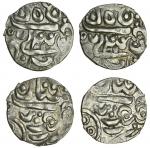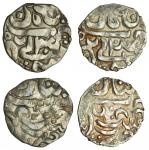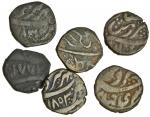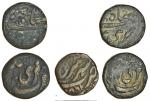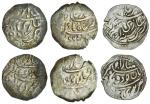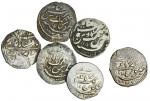1815-59Sudarshan Shah金币10.57g 近未流通。The Nicholas Rhodes Collection: Coins of North East India (Part 2)。Tehri Garhwal, Sudarshan Shah (1815-59) gold donative Mohur, 10.57g, Samvat 1872 (1815), Arabic legends, Mahārāja Sudarshan Shāh, Samvat 1872, rev. Nagari ?Śrī? at top, Arabic legend below commencing ?Badrinātha? (Rhodes, JONS 134, Aug-Oct 1992, ?The Gold Coins of Sudarshan Shah of Tehri Garhwal?), about uncirculated, as struck, and extremely rare. Subject to 20% VAT on Buyer?s Premium. For more information please view Terms and Conditions for Buyers.。
This coin was acquired by Nicholas Rhodes from ?the son of a former Nepalese ambassador to the UK, who comes from a Hindu family with origins in the far west of Nepal.?A similar coin appeared in Spink-Taisei Singapore Coin Auction, 20íth February 1991, attributed to ?Sudarshan Shah of Bhadaranath, AD1872?. Rhodes notes that similar coins had been sold by Steve Album (List 48, Dec.1986, item 165) and Bob Senior (List 8). Rhodes reassigned the date to the accession year of of Tehri Garhwal: Samvat 1872 (1815), 57 years earlier than described previously. Sudarshan Shah was the heir of Parduman Shah who ruled Garhwal until his kingdom was conquered by the Nepalese in 1804.
During the Nepalese occupation Sudarshan took refuge in Bareilly, only returning after the British annexed Kumaon and Garhwal after the Gorkha war. A portion of the previous state of Garhwal was handed back to Sudarshan Shah, who chose Tehri as his capital, hence the name Tehri Garhwal. In return, Sudarshan Shah had to provide assistance and supplies to the British. He remained loyal to them throughout the 1857 Mutiny, until his death in 1859.Rhodes suggests the word ?Badrinatha? on the reverse of the coin was a reference to the famous Hindu temple near the source of the Alakananda River, one of the main branches of the Ganges. However, although this temple was situated in the original territory of Garhwal, by this time it stood in an area directly controlled by the British, and not in Tehri Garhwal. Also, there is no record that the British had ever given Sudarshan Shah permission to strike coins for circulation.
Rhodes therefore postulates that this may have been a donative coin, struck by Sudarshan Shah in his own name in order that he might gain merit from the god. He also mentions the fact that when the temple had been in Garhwal the Rajas had made a habit of borrowing from the treasury to fund certain campaigns, using the revenue from various villages as collateral. It is therefore also possible that these, and similar coins, were used to repay these loans. Rhodes describes two types of similar coins: hand-struck Mohurs and Half-Mohurs such as this, and machine-struck Mohurs that he presumes were struck after 1835 as they follow a later weight standard.One of the machine-struck issues sold for £16,000 at Baldwin, Auction 84, 25 Sept 2013, lot 1703










